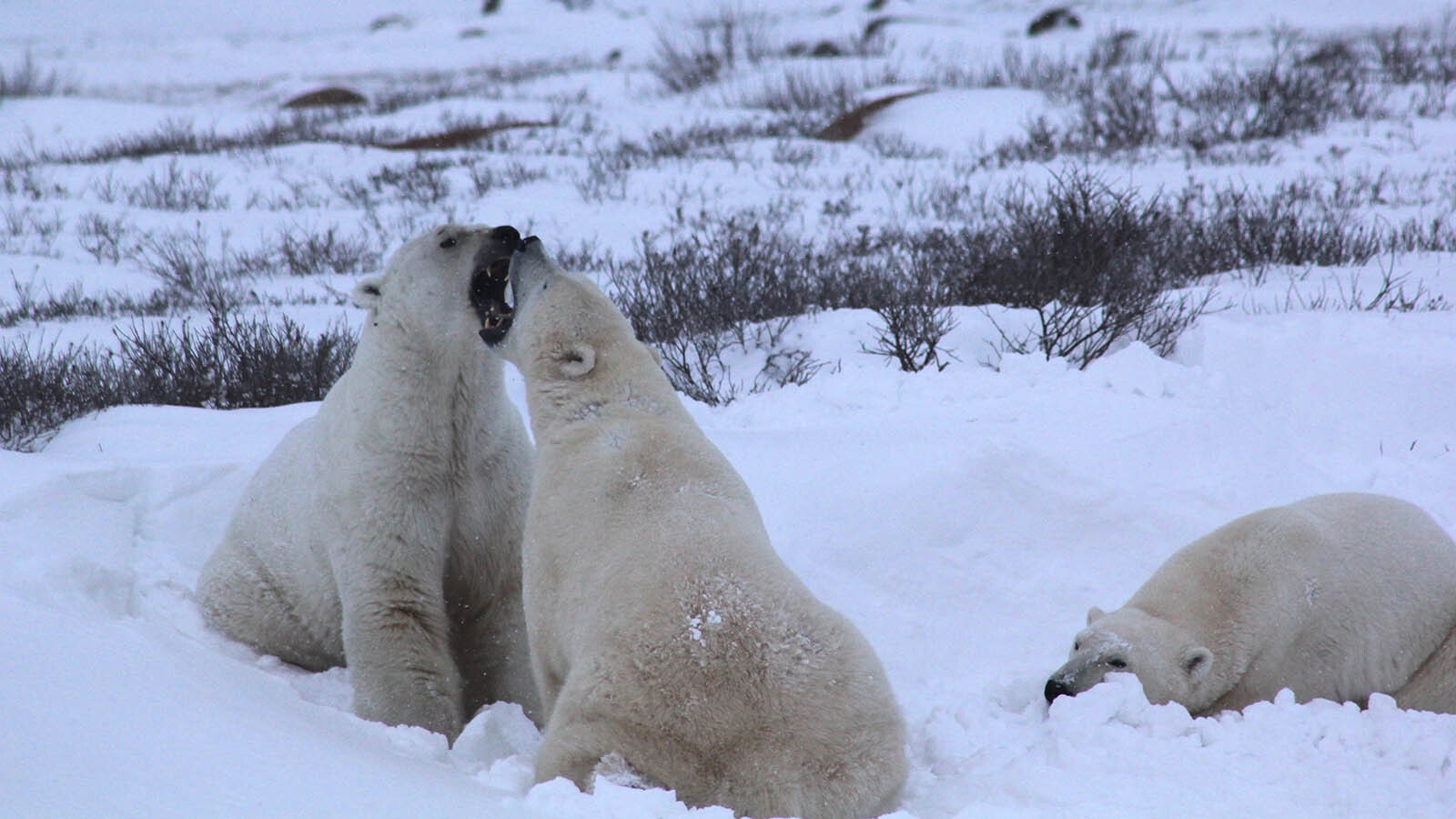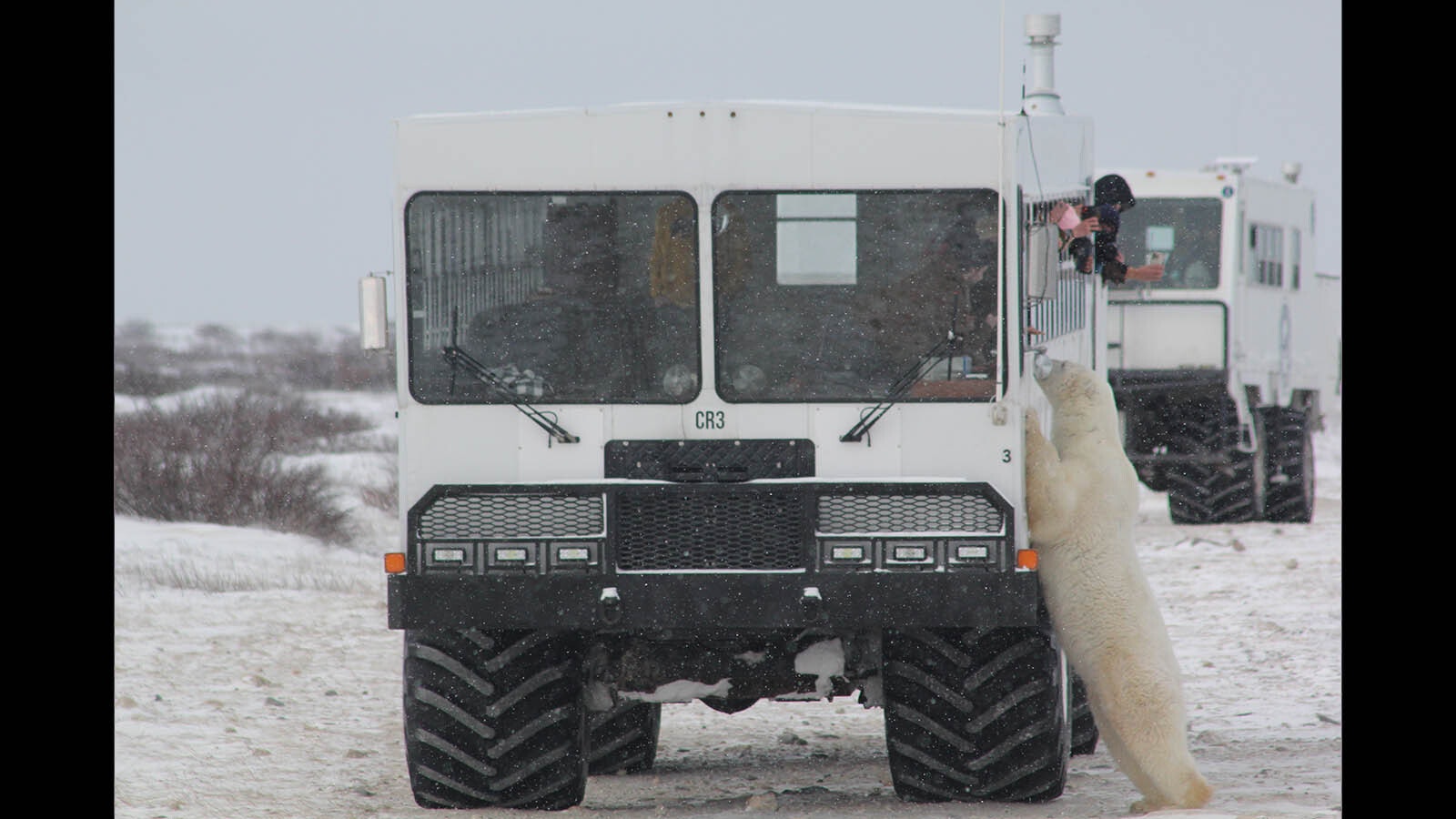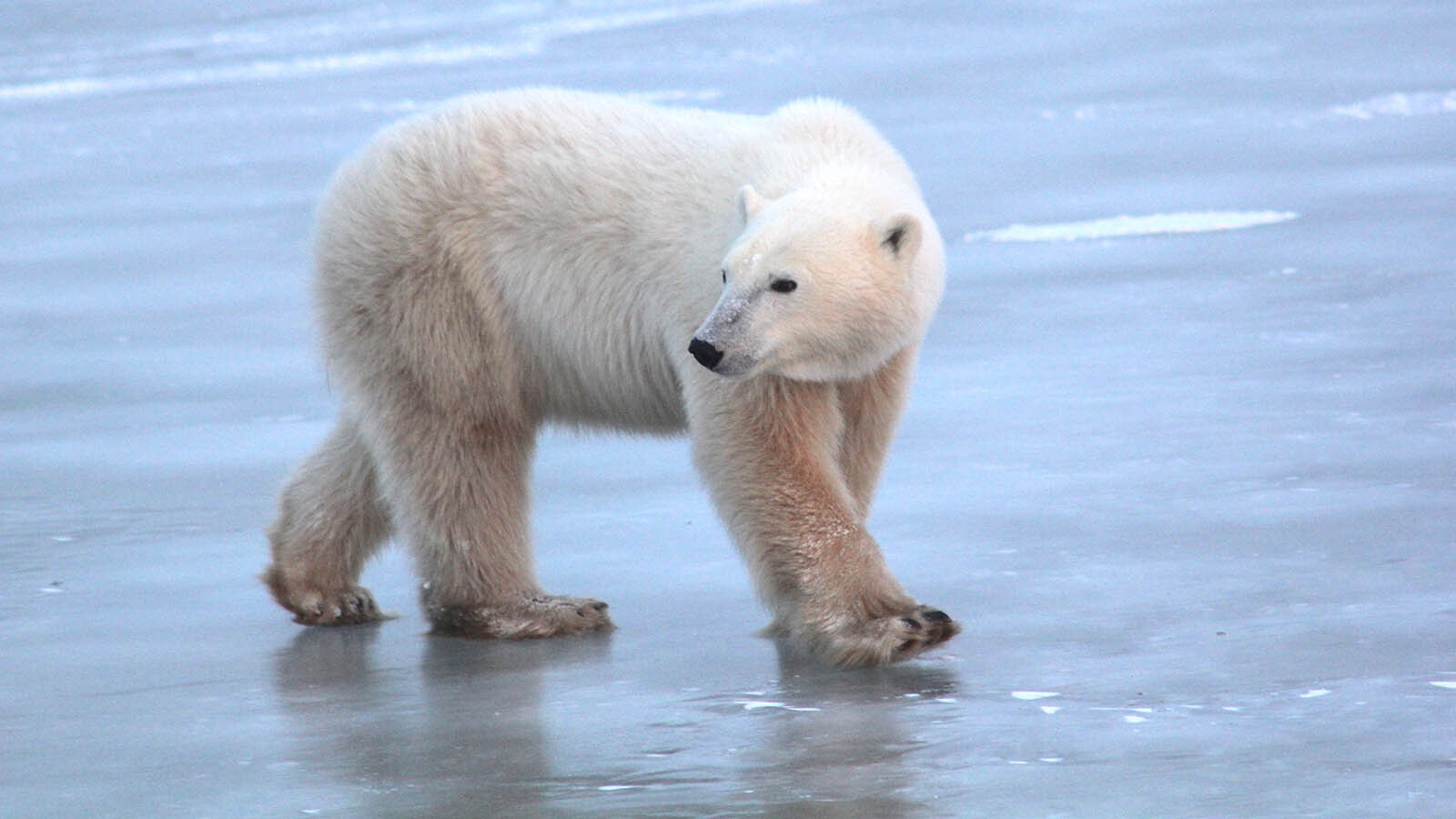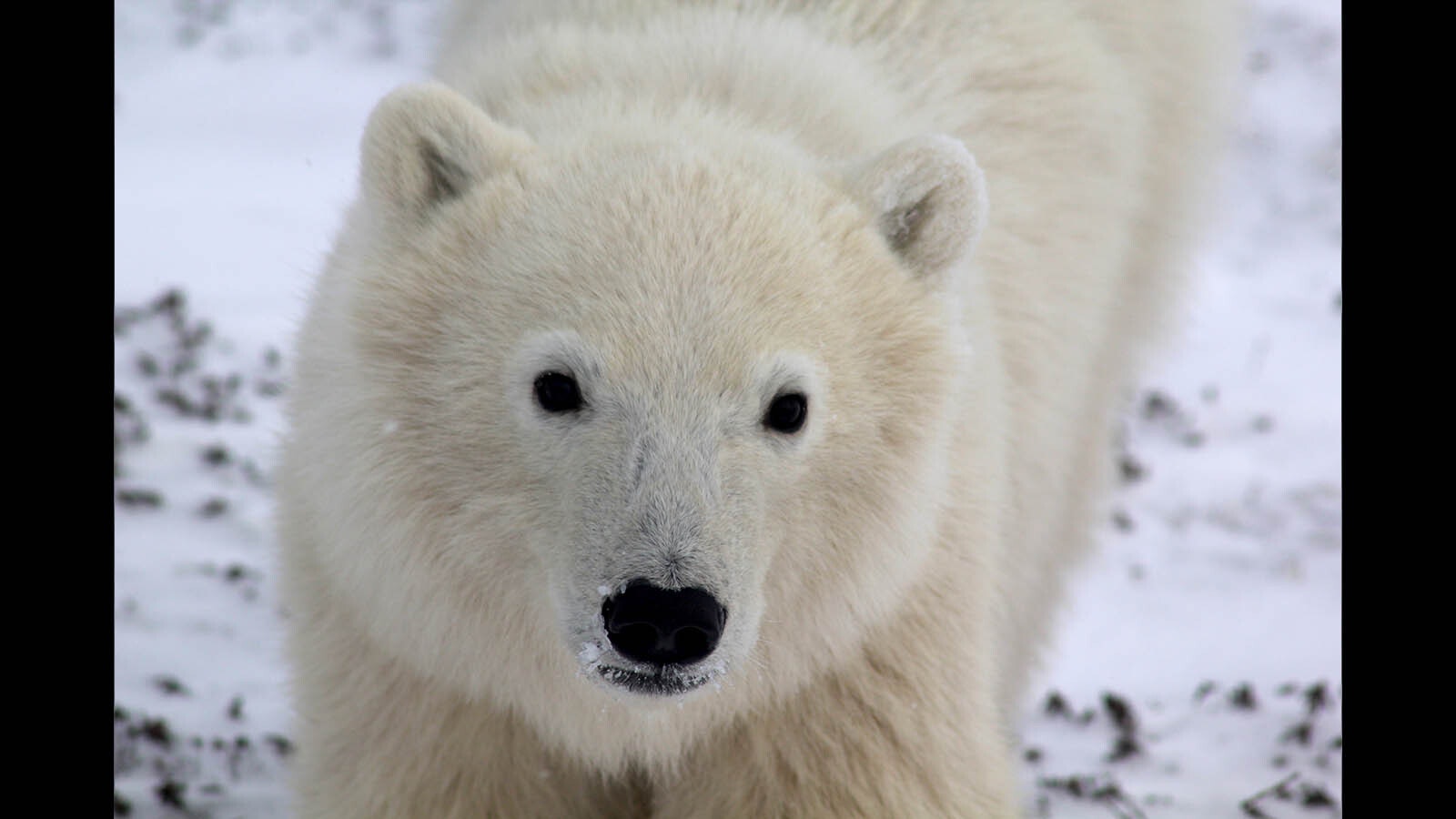My first glimpse of a wild polar bear was a set of tracks on the ground just outside the window of a unique lodge at the edge of Hudson Bay east of Churchill in Manitoba, Canada.
The track was clearly fresh. It was compacted snow in the shape of a polar bear foot — all the snow around it had disappeared in the wind that sifts almost constantly across the tundra.
About an hour later, as we finished our dinner, one of the guides at the Tundra Buggy Lodge came into the dining room and announced there were two bears sparring just outside the ring of light from the lodge.
In the lounge, with all the lights off inside, I could scrunch my nose against the glass and see the bears, which were just shadowy figures who appeared to be boxing.
The Tundra Buggy Lodge resembles a train with multiple cars that serve different purposes. It has a crew car, a kitchen/dining car, a lounge car and two sleeping cars. Bunk beds in berths, with privacy provided by a double row of curtains, served as sleeping quarters. Each berth has a small window.
When I climbed into my bunk, my husband in the top berth whispered, “Candy, look out the window right now!”
A polar bear was strolling by. He stopped to look right at me. He might have thought, “I’m out here wild and free and you are the one in the cage.”
It was surreal and exhilarating.
700 Polar Bears
All thought of sleep was gone as I pulled on snow pants and my heavy parka to head outside into the cold night to watch bears from the viewing platform between the lounge and sleeping cars.
I’d been waiting years for a chance to see polar bears in the wild and did not want to miss a moment of this experience.
But alas, it is COLD on the sub-Arctic tundra, and eventually I retreated to my bunk.
Around 700 polar bears are part of the population that lives in the western Hudson Bay quadrant near Churchill. They are among the most studied polar bears on the planet.
They are somewhat predictable and they spend almost half a year at the edge of Hudson Bay.
Polar Bear International (PBI) has a headquarters in Churchill with a revolving cadre of researchers, biologists and experts who watch the bears, sometimes capturing one to tag and place a radio collar over its head to track movements.
As an apex predator, polar bears aren’t frightened of anything really. They would kill a dog or a human, but their prey of choice are the seals that live in Hudson Bay, which they can hunt only when the water in the bay freezes into a massive ice pack.
On the day in mid-November when we visited Polar Bear International headquarters, the bears had been on land and had not eaten for 154 days.
Out on the tundra, they were starting to congregate in anticipation of pack ice and seal hunting.

Tundra Buggy Transportation
The way to see the bears is riding a big vehicle called a tundra buggy.
Built like a huge school bus, the buggies have oversized rubber tires so they can negotiate uneven ground that is often wet and muddy, or icy. They are tall, so when a polar bear stands up and leans against the buggy it cannot reach the people with their cameras and binoculars.
Several companies have the big vehicles and they take tours into the Churchill Wildlife Management Area for sightings of foxes, ptarmigan, sandhill cranes, moose and other large and small animals and birds. But their most desirable tour is to see the polar bears in October and November.
The Churchill WMA borders Wapusk National Park, one of the world’s largest-known maternity denning areas for polar bears. The only two bear sows we saw each had one cub, and they were both on the move headed toward Wapusk, which was likely a safer area for them away from the male bears congregating near the bay.
We traveled with Frontiers North and toured with the original Tundra Buggy Lodge company. They built the first buggies and started their business in 1979. Every other company is a copycat. Even PBI relies on the technology, location and experience of Tundra Buggy Lodge.
Once you board one of the buggies, you don’t set foot on ground again until your tour is over – in our case four days later. The buggies dock at the Tundra Buggy Lodge for overnight stays. But during the day they roam across the tundra in search of bears.
Not counting those from the lodge windows, we had nearly 70 bear observation opportunities.
Wrestlers Of The North
Male bears act a lot like teenage boys. They were constantly pushing and shoving each other (sparring), rolling around and wrestling. And sleeping.
It was easy to understand that they weren’t teenagers, however, because they weren’t eating.
From the time pack ice breaks up in early summer until it forms again in late fall, the bears live on land and the fat resources they have stored from a winter of hunting and eating fat seals.
If we ate the amount and kind of blubber they rely on, it wouldn’t take long to drop over dead from clogged arteries. But polar bears can uniquely metabolize all that fat.
As the ice pack built — it was significantly growing even on our short trip to Hudson Bay — you could almost see the bears smacking their lips at the idea of a feast waiting for them in the cold water.
When it looked like they were bored and yawning, our guide instead told us they were opening their mouths wide because that is how they smell. Their eyesight isn’t great, but they can smell a seal through feet of pack ice … or the aroma of a couple of Wyoming tourists standing on the back platform of the tundra buggy.
Hold On To Your Hat!
There are similarities to the tundra near Hudson Bay and Wyoming – the wind!
It snows up there, but not near as much as we get in a winter at the base of the Sierra Madre near Encampment.
It is colder, generally, but with warm winter gear certainly tolerable.
We took heavy, warm snow boots and didn’t really need them, though they were good when walking on icy paths in the town of Churchill and out at Fort Churchill, a Parks Canada site where rangers stood guard with their rifles.
Like Wyoming, much of the economy in Churchill is based on tourism. Polar bears are the big draw, but in the summer beluga whale tours are popular when those whales calve in the rivers feeding Hudson Bay.
In the dark days of winter, people visit to view the Aurora Borealis, which plays a nightly light show 360 days of the year. That doesn’t mean you see the Northern Lights that much because clouds often obscure the night sky.
One advantage to visiting Churchill is that you don’t have to worry about whether the road will be open. They have no I-80. In fact, they have no access road to the town at all. The only way to get to Churchill is on a plane or a train.
Most of the roads used by the tundra buggies are old military roads on the Churchill Rocket Research Range established in the 1950s when missile-based research was underway. The main use of U.S. rockets near Hudson Bay were to study the atmosphere — specifically, the Aurora. For years, the complex was Canada’s premier upper atmosphere research center.
Around 870 people make their home in Churchill. I suspect half of them are seasonal tour guides and service workers on hand to sling the hash and make the beds for tourists.
The place physically was not a lot bigger than Riverside Wyoming, just a few blocks long and wide. We were warned not to walk in alleys, where polar bears like to sleep. And told if we saw a bear to duck into the nearest house, business or vehicle. Locals don’t lock their cars so they are always a refuge if a bear is too close.
Polar Bear Jail
The primary duty of the local law enforcement officers is to keep the bears out of town.
Problem bears are captured and thrown in Polar Bear Jail for 30 days. The jail is dark, there are individual holding cells, and the only care the bears get is water (they don’t eat anyway).
After 30 days, those bears are released in locations away from town. The goal is to make “town visits” uncomfortable so the bears don’t return. Sometimes it even works.
PBI research shows that the bears in the management area around Churchill are declining in numbers, down from around 850 a decade ago to about 700 now. But that doesn’t mean polar bear populations overall are down.
Quite the contrary, the number of polar bears in all management areas are up over the last few decades. Our guide told us the Churchill bears are likely migrating away from that area and to other more remote regions to the north and west, which accounts for the shifting numbers.
The greatest contributing factor to increased numbers of polar bears is the fact that hunting has been severely restricted. For the most part, the only harvest of polar bears is by indigenous people.
There are other risks to the bears, however. PBI stresses to any visitor in Churchill that the warming climate is affecting the pack ice – how long it is in place and how deep it becomes. That in turn impacts seal hunting for polar bears. Without pack ice and seals, polar bears are doomed.
Of all the bears we saw on our trip, only one looked like he was REALLY ready for a seal smorgasbord. He was big, likely pretty old and skinny. For his sake I hope the pack ice we saw building was soon strong enough that he could go out and scoop a fat seal out for dinner.
Candy Moulton is a longtime Wyoming journalist who recently did a series for Cowboy State Daily on members in the Wyoming Cowboy Hall of Fame.
Candy Moulton can be reached at Candy.L.Moulton@gmail.com.









